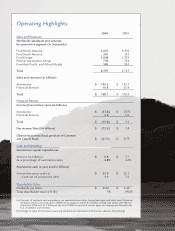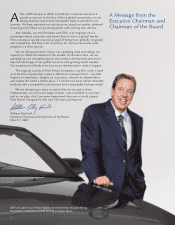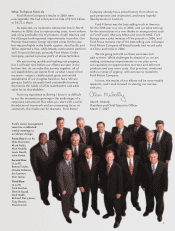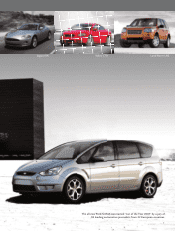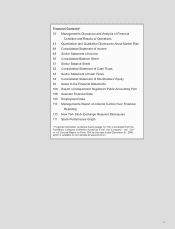Ford 2006 Annual Report Download - page 13
Download and view the complete annual report
Please find page 13 of the 2006 Ford annual report below. You can navigate through the pages in the report by either clicking on the pages listed below, or by using the keyword search tool below to find specific information within the annual report.
Management’s Discussion and Analysis of Financial Condition and Results of Operations
Pricing Pressure. Excess capacity, coupled with a proliferation of new products being introduced in key segments by
the industry, will keep pressure on manufacturers' ability to increase prices on their products. In addition, the incremental
new U.S. manufacturing capacity of Japanese and Korean manufacturers in recent years has contributed, and is likely to
continue to contribute, to the severe pricing pressure in that market. For example, in 2006, Toyota completed construction
of an assembly plant in Texas that reportedly will be capable of producing at least 200,000 full-size pick-up trucks per year.
The reduction of real prices for similarly contented vehicles in the United States has become more pronounced since the
late 1990s, and we expect that a challenging pricing environment will continue for some time to come. In addition, the
Japanese yen remains weak against the U.S. dollar and at historic lows against the euro, contributing substantially to
Japanese vehicle manufacturers' significant cost advantage, especially on exports from Japan to these markets. In
Europe, the automotive industry also has experienced intense pricing pressure for several years, exacerbated in recent
years by the Block Exemption Regulation.
Consumer Spending Trends. We expect, however, that a decline in or the inability to increase vehicle prices could be
offset by the spending habits of consumers and their propensity to purchase over time higher-end, more expensive
vehicles and/or vehicles with more features. Over the next decade, in the United States and other mature markets, we
expect that growth in spending on vehicle mix and content will change generally in line with GDP or above. The benefits
of this to revenue growth in the automotive industry are significant. In the United States, for example, consumers in the
highest income brackets are buying more often and are more frequently buying upscale.
Although growth in wholesales (i.e., volume) will be greatest in emerging markets in the next decade, we expect that
the mature automotive markets (e.g., North America, Western Europe, and Japan) will continue to be the source of a
majority of global industry revenues. We also expect that the North American market will continue as the single largest
source of revenue for the automotive industry in the world.
Health Care Expenses. In 2006, our health care expenses for U.S. employees, retirees, and their dependents were
$3.1 billion, with about $1.8 billion for postretirement health care and the balance for active employee health care and
other retiree expense.
Although we have taken measures to have employees and retirees bear a higher portion of the costs of their health
care benefits, we expect our health care costs to continue to increase. For 2007, our trend assumptions for U.S. health
care costs include an initial trend rate of six percent, gradually declining to a steady state trend rate of five percent
reached in 2011. These assumptions include the effect of actions we are taking and expect to take to offset health care
inflation, including eligibility management, employee education and wellness programs, competitive sourcing, and
employee cost sharing.
Commodity and Energy Price Increases. Commodity price increases, particularly for steel and resins (which are our
two largest commodity exposures and among the most difficult to hedge), have occurred recently and are continuing
during a period of strong global demand for these materials. In addition, energy prices continued to increase significantly
in 2006. In particular, gasoline prices in the United States increased in volatility and rose to levels over $3.00 per gallon in
2006. Although prices have moderated somewhat, they remain and are expected to remain at high levels. This has had
an adverse effect on the demand for full- and medium-sized sport utility vehicles and trucks in the United States.
Currency Exchange Rate Volatility. The U.S. dollar has depreciated against most major currencies since 2002. This
created downward margin pressure on auto manufacturers that have U.S. dollar revenue with foreign currency cost.
Because we produce vehicles in Europe (e.g., Jaguar, Land Rover, Aston Martin and Volvo models) for sale in the United
States and produce components in Europe (e.g., engines) for use in some of our North American vehicles, we
experienced margin pressure. Although this pressure was offset partially by gains on foreign exchange derivatives, this
offset declines over time due to the expiration of favorable hedges previously put in place. We, like many other
automotive manufacturers with sales in the United States, are not always able to price for depreciation of the U.S. dollar
due to the extremely competitive pricing environment in the United States.
11


